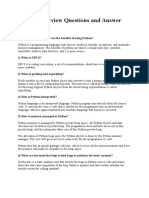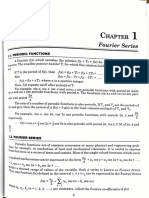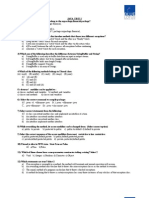Python_Viva_Questions
Uploaded by
ytsubscribers.sgPython_Viva_Questions
Uploaded by
ytsubscribers.sgPython Programming Viva Questions and Answers
### Programming with Python: Basics
1. What is Python, and why is it popular?
- Python is a high-level, interpreted programming language known
for its simplicity and readability. Its popularity comes from its
versatility, extensive libraries, and active community support.
2. Who developed Python, and when?
- Python was developed by Guido van Rossum in 1991.
3. What are some key features of Python?
- Easy to learn and use, interpreted language, platform-independent,
supports object-oriented programming, has extensive libraries, and is
open-source.
4. How do you set up Python on your system?
- Download and install Python from python.org. Add Python to the
system PATH during installation for easy execution from the
command line.
5. What are the basic data types in Python?
- Integer, Float, String, Boolean, List, Tuple, Dictionary, and Set.
### Conditional Statements
6. What is the syntax for an if-else statement in Python?
if condition:
# code block
else:
# another code block
7. Can you nest if-else statements in Python? Provide an example.
- Yes, nested if-else statements are allowed.
if x > 0:
if x % 2 == 0:
print("Positive Even")
else:
print("Positive Odd")
else:
print("Non-positive")
### Looping
8. What are the differences between for and while loops in Python?
- A for loop is used when the number of iterations is known
beforehand (e.g., iterating over a list). A while loop is used when the
number of iterations depends on a condition.
9. What is a nested loop? Provide an example.
- A loop inside another loop is called a nested loop.
for i in range(3):
for j in range(3):
print(i, j)
10. What does the break statement do in a loop?
- It terminates the current loop prematurely.
### String Manipulation
11. How do you access individual characters in a string?
- Using indexing: string[index]
Example:
s = "Python"
print(s[0]) # Output: P
12. What is string slicing?
- Slicing extracts a part of the string.
s = "Python"
print(s[1:4]) # Output: yth
13. Name some string methods.
- upper(), lower(), strip(), split(), join(), find(), replace().
### Lists
14. How do you declare a list in Python?
- Using square brackets:
my_list = [1, 2, 3]
15. What are some common list methods?
- append(), extend(), insert(), remove(), pop(), sort(), reverse().
16. How can you access elements in a list?
- Using indexing and slicing:
my_list = [10, 20, 30]
print(my_list[1]) # Output: 20
### Tuples
17. What is the difference between a list and a tuple?
- A list is mutable (modifiable), while a tuple is immutable (cannot
be modified).
18. How can you access elements in a tuple?
- Using indexing and slicing, similar to lists.
### Dictionaries
19. What is a dictionary in Python?
- A dictionary is a collection of key-value pairs.
Example:
my_dict = {"name": "John", "age": 30}
20. How do you access values in a dictionary?
- Using keys:
print(my_dict["name"]) # Output: John
### Functions
21. What are the types of functions in Python?
- Built-in functions and user-defined functions.
22. What is an anonymous function?
- A function defined using the lambda keyword.
add = lambda x, y: x + y
print(add(2, 3)) # Output: 5
23. What are function arguments?
- Arguments can be positional, keyword, default, or variable-length.
### Modules
24. How do you import a module in Python?
- Using the import keyword.
import math
print(math.sqrt(16))
25. What is the difference between a module and a package?
- A module is a single file, while a package is a collection of
modules organized in directories.
### File Handling
26. How do you open a file in Python?
- Using the open() function:
file = open("example.txt", "r")
27. What are the different file modes in Python?
- r (read), w (write), a (append), rb (read binary), etc.
28. How do you read and write data to a file?
- Use read() or write().
Example:
with open("example.txt", "w") as file:
file.write("Hello, World!")
### Exception Handling
29. What is exception handling in Python?
- A mechanism to handle runtime errors using try, except, finally.
30. Can you define a custom exception?
- Yes, by inheriting from the Exception class.
class MyError(Exception):
pass
You might also like
- 300 Python Interview Questions and Solutions100% (1)300 Python Interview Questions and Solutions88 pages
- Python Interview Questions and Answers for FreshersNo ratings yetPython Interview Questions and Answers for Freshers7 pages
- 80 Python Interview Questions & AnswersNo ratings yet80 Python Interview Questions & Answers23 pages
- Python Questions for Cloudy Coders DriveNo ratings yetPython Questions for Cloudy Coders Drive28 pages
- Top 25 Python Programming Viva QuestionsNo ratings yetTop 25 Python Programming Viva Questions4 pages
- Python Sample Viva Questions for Academic Session 2024-2025No ratings yetPython Sample Viva Questions for Academic Session 2024-20256 pages
- Top 50+ Python Interview Questions and Answers (Latest 2024)No ratings yetTop 50+ Python Interview Questions and Answers (Latest 2024)14 pages
- Python Interview Questions Answers Free PDFNo ratings yetPython Interview Questions Answers Free PDF16 pages
- Python programming interview questions and answers pdfNo ratings yetPython programming interview questions and answers pdf6 pages
- Python Interview Questions and Answers PDFNo ratings yetPython Interview Questions and Answers PDF4 pages
- python programming question bank unit wise by Rupesh ✓No ratings yetpython programming question bank unit wise by Rupesh ✓24 pages
- Python Important Questions For Mid Term Exam..No ratings yetPython Important Questions For Mid Term Exam..10 pages
- Mastering Python Programming: A Comprehensive Guide: The IT CollectionFrom EverandMastering Python Programming: A Comprehensive Guide: The IT Collection5/5 (1)
- Python programming for beginners: Python programming for beginners by Tanjimul Islam TareqFrom EverandPython programming for beginners: Python programming for beginners by Tanjimul Islam TareqNo ratings yet
- Assignment - Week 6 (Generics, Comparable) : 0. Warm-UpNo ratings yetAssignment - Week 6 (Generics, Comparable) : 0. Warm-Up4 pages
- Diploma in Communication and ComputernetworkingNo ratings yetDiploma in Communication and Computernetworking4 pages
- Full Download Readings from Programming with C++ 1st Edition Kyla Mcmullen PDF DOCX100% (1)Full Download Readings from Programming with C++ 1st Edition Kyla Mcmullen PDF DOCX65 pages
- Kendriya Vidyalaya Fortwilliam Class Xii Cs Monthly Test August Out oNo ratings yetKendriya Vidyalaya Fortwilliam Class Xii Cs Monthly Test August Out o5 pages
- ITC C106 Lecture - Basic Exception HandlingNo ratings yetITC C106 Lecture - Basic Exception Handling13 pages
- Features of OOP: - Object - Class - Inheritance - Polymorphism - Abstraction - EncapsulationNo ratings yetFeatures of OOP: - Object - Class - Inheritance - Polymorphism - Abstraction - Encapsulation62 pages
- Subject - Object Oriented Programming With C++ Topic: C++ Stream ClassesNo ratings yetSubject - Object Oriented Programming With C++ Topic: C++ Stream Classes25 pages
- Python Interview Questions and Answers for FreshersPython Interview Questions and Answers for Freshers
- Python Sample Viva Questions for Academic Session 2024-2025Python Sample Viva Questions for Academic Session 2024-2025
- Top 50+ Python Interview Questions and Answers (Latest 2024)Top 50+ Python Interview Questions and Answers (Latest 2024)
- Python programming interview questions and answers pdfPython programming interview questions and answers pdf
- python programming question bank unit wise by Rupesh ✓python programming question bank unit wise by Rupesh ✓
- Mastering Python Programming: A Comprehensive Guide: The IT CollectionFrom EverandMastering Python Programming: A Comprehensive Guide: The IT Collection
- Python programming for beginners: Python programming for beginners by Tanjimul Islam TareqFrom EverandPython programming for beginners: Python programming for beginners by Tanjimul Islam Tareq
- Assignment - Week 6 (Generics, Comparable) : 0. Warm-UpAssignment - Week 6 (Generics, Comparable) : 0. Warm-Up
- Full Download Readings from Programming with C++ 1st Edition Kyla Mcmullen PDF DOCXFull Download Readings from Programming with C++ 1st Edition Kyla Mcmullen PDF DOCX
- Kendriya Vidyalaya Fortwilliam Class Xii Cs Monthly Test August Out oKendriya Vidyalaya Fortwilliam Class Xii Cs Monthly Test August Out o
- Features of OOP: - Object - Class - Inheritance - Polymorphism - Abstraction - EncapsulationFeatures of OOP: - Object - Class - Inheritance - Polymorphism - Abstraction - Encapsulation
- Subject - Object Oriented Programming With C++ Topic: C++ Stream ClassesSubject - Object Oriented Programming With C++ Topic: C++ Stream Classes

























































































